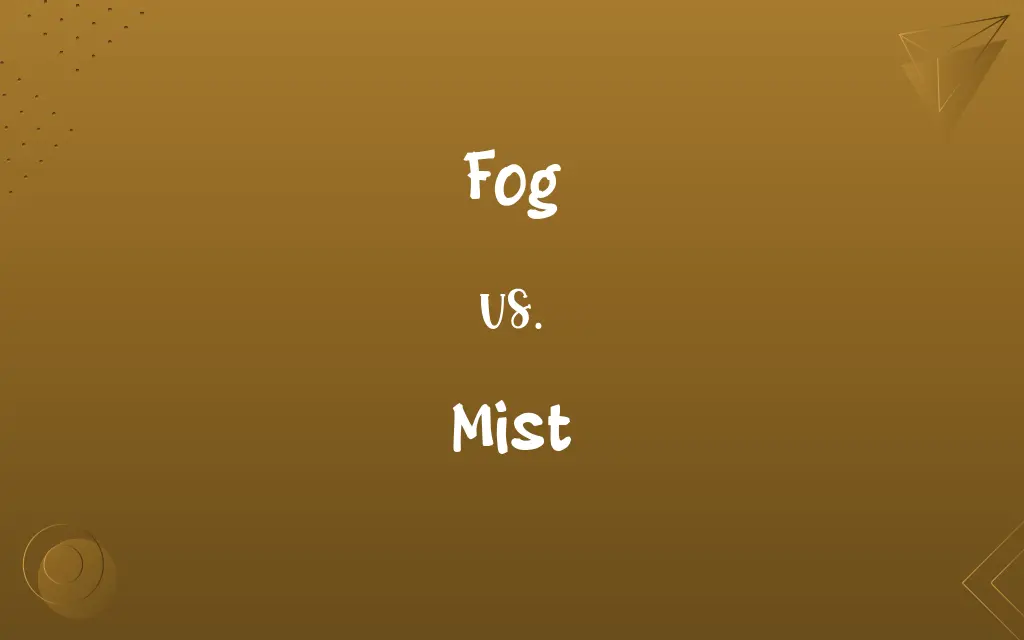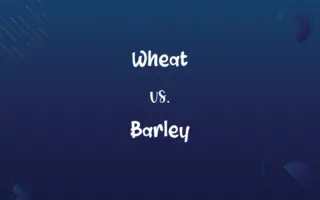Fog vs. Mist: Know the Difference

By Shumaila Saeed || Updated on December 25, 2023
Fog is a thicker, denser cloud of tiny water droplets near the ground, reducing visibility more significantly than mist, which is lighter and less obscuring.

Key Differences
Fog and mist are two meteorological phenomena that involve the suspension of water droplets in the air, but they differ in terms of their characteristics and visibility.
Shumaila Saeed
Nov 21, 2023
Fog is a type of atmospheric condition characterized by a thick concentration of tiny water droplets or ice crystals suspended near the Earth's surface. Fog often reduces visibility to less than 1 kilometer (0.62 miles) and can vary in thickness, from a light haze to a dense, opaque cloud-like formation. Fog typically occurs when moist air cools and reaches its dew point, causing water vapor to condense into tiny droplets. It is commonly observed in the early morning or late evening when the ground has cooled overnight, and the air becomes saturated with moisture. Fog can be quite dense and can significantly impair visibility, leading to hazardous driving conditions and disruptions in transportation.
Shumaila Saeed
Nov 21, 2023
On the other hand, mist is a milder form of atmospheric moisture compared to fog. Mist consists of tiny water droplets suspended in the air, but these droplets are much finer and less dense than those found in fog. Mist typically results from high humidity and often occurs in the presence of light rain or drizzle. It can create a light, hazy appearance in the atmosphere and reduce visibility slightly, typically to a range of 1 to 2 kilometers (0.62 to 1.24 miles). Mist is usually not as thick or opaque as fog, allowing for better visibility for motorists and pedestrians. It is commonly encountered in coastal areas or near bodies of water where moisture is abundant.
Shumaila Saeed
Nov 21, 2023
In summary, the primary difference between fog and mist lies in their density and visibility-impairing effects. Fog is characterized by its thick concentration of water droplets, which can significantly reduce visibility to less than 1 kilometer. In contrast, mist consists of finer and less dense water droplets, resulting in slightly reduced visibility of 1 to 2 kilometers. Both phenomena are the result of moisture in the atmosphere, but they vary in intensity, with fog being the more severe of the two in terms of visibility obstruction. Understanding these differences is essential for safety and navigation in various weather conditions.
Shumaila Saeed
Nov 21, 2023
Comparison Chart
Visibility Reduction
Significantly reduces visibility
Slightly reduces visibility
Shumaila Saeed
Nov 21, 2023
ADVERTISEMENT
Formation Conditions
Specific humidity and temperature conditions
Forms with lesser humidity and temperature differences
Shumaila Saeed
Nov 21, 2023
Fog and Mist Definitions
Fog
Can be categorized into types like radiation fog and advection fog.
The city often experiences advection fog due to the nearby ocean.
Shumaila Saeed
Nov 17, 2023
ADVERTISEMENT
Mist
A light cloud of water droplets suspended in the air, slightly obscuring visibility.
The morning mist over the lake gave a serene start to the day.
Shumaila Saeed
Nov 17, 2023
Fog
Condensed water vapor in cloudlike masses lying close to the ground and limiting visibility.
Shumaila Saeed
Oct 19, 2023
Mist
Formed when warmer air passes over cooler surfaces, causing condensation.
Mist often forms over rivers in early autumn mornings.
Shumaila Saeed
Nov 17, 2023
Mist
Thinner than fog, allowing for better visibility.
Despite the mist, the outline of the mountains was still visible.
Shumaila Saeed
Nov 17, 2023
ADVERTISEMENT
Mist
Common in areas near water bodies and in hilly regions.
The misty hills added a magical touch to the landscape.
Shumaila Saeed
Nov 17, 2023
Fog
A cloud of vaporized liquid, especially a chemical spray used in fighting fires.
Shumaila Saeed
Oct 19, 2023
Mist
Often dissipates with the rise of the morning sun.
As the sun rose, the mist slowly cleared, revealing the fields.
Shumaila Saeed
Nov 17, 2023
Mist
A mass of fine droplets of water in the atmosphere near or in contact with the earth.
Shumaila Saeed
Oct 19, 2023
Fog
Something that obscures or conceals; a haze
Shrouded their actions in a fog of disinformation.
Shumaila Saeed
Oct 19, 2023
Mist
Fine drops of a liquid, such as water, perfume, or medication, sprayed into the air.
Shumaila Saeed
Oct 19, 2023
Fog
A new growth of grass appearing on a field that has been mowed or grazed.
Shumaila Saeed
Oct 19, 2023
Mist
Something that produces or gives the impression of dimness or obscurity
The mists of the past.
Shumaila Saeed
Oct 19, 2023
Mist
To moisturize (plants or dry air, for example) with a fine spray of water.
Shumaila Saeed
Oct 19, 2023
Fog
(uncountable) A thick cloud that forms near the ground; the obscurity of such a cloud. mist, haze.}}
A bank of fog
Shumaila Saeed
Oct 19, 2023
Mist
Water or other liquid finely suspended in air. fog, haze.}}
It was difficult to see through the morning mist.
Shumaila Saeed
Oct 19, 2023
Mist
(countable) A layer of fine droplets or particles.
There was an oily mist on the lens.
Shumaila Saeed
Oct 19, 2023
Fog
A state of mind characterized by lethargy and confusion.
He did so many drugs, he was still in a fog three months after going through detox.
Shumaila Saeed
Oct 19, 2023
Fog
(photography) A silver deposit or other blur on a negative or developed photographic image.
Shumaila Saeed
Oct 19, 2023
Mist
To spray fine droplets on, particularly of water.
I mist my tropical plants every morning.
Shumaila Saeed
Oct 19, 2023
Fog
A new growth of grass appearing on a field that has been mowed or grazed.
Shumaila Saeed
Oct 19, 2023
Fog
Tall and decaying grass left standing after the cutting or grazing season.
Shumaila Saeed
Oct 19, 2023
Mist
(of the eyes) To be covered by tears.
My eyes misted when I remembered what had happened.
Shumaila Saeed
Oct 19, 2023
Mist
To disperse into a mist, accompanying operation of equipment at high speeds.
Shumaila Saeed
Oct 19, 2023
Mist
Visible watery vapor suspended in the atmosphere, at or near the surface of the earth; fog.
Shumaila Saeed
Oct 19, 2023
Fog
(intransitive) To become obscured in condensation or water.
The mirror fogged every time he showered.
Shumaila Saeed
Oct 19, 2023
Mist
Coarse, watery vapor, floating or falling in visible particles, approaching the form of rain; as, Scotch mist.
Shumaila Saeed
Oct 19, 2023
Mist
Hence, anything which dims or darkens, and obscures or intercepts vision.
His passion cast a mist before his sense.
Shumaila Saeed
Oct 19, 2023
Fog
To spoil (film) via exposure to light other than in the normal process of taking a photograph.
Shumaila Saeed
Oct 19, 2023
Fog
(transitive) To disperse insecticide into (a forest canopy) so as to collect organisms.
Shumaila Saeed
Oct 19, 2023
Fog
(transitive) To pasture cattle on the fog (of), or aftergrass, of; to eat off the fog from (a field).
Shumaila Saeed
Oct 19, 2023
Fog
Watery vapor condensed in the lower part of the atmosphere and disturbing its transparency. It differs from cloud only in being near the ground, and from mist in not approaching so nearly to fine rain. See Cloud.
Shumaila Saeed
Oct 19, 2023
Fog
Cloudiness or partial opacity of those parts of a developed film or a photograph which should be clear.
Shumaila Saeed
Oct 19, 2023
Fog
To pasture cattle on the fog, or aftergrass, of; to eat off the fog from.
Shumaila Saeed
Oct 19, 2023
Fog
To practice in a small or mean way; to pettifog.
Where wouldst thou fog to get a fee?
Shumaila Saeed
Oct 19, 2023
Fog
To render semiopaque or cloudy, as a negative film, by exposure to stray light, too long an exposure to the developer, etc.
Shumaila Saeed
Oct 19, 2023
Fog
To show indistinctly or become indistinct, as the picture on a negative sometimes does in the process of development.
Shumaila Saeed
Oct 19, 2023
Fog
An atmosphere in which visibility is reduced because of a cloud of some substance
Shumaila Saeed
Oct 19, 2023
Fog
A thick cloud of tiny water droplets near the ground, reducing visibility.
The dense fog made driving conditions difficult this morning.
Shumaila Saeed
Nov 17, 2023
Fog
Forms when ground-level air cools and becomes saturated with moisture.
Fog often forms in valleys where cold air settles.
Shumaila Saeed
Nov 17, 2023
Fog
Common in areas with high humidity and temperature inversions.
Coastal regions frequently experience foggy mornings.
Shumaila Saeed
Nov 17, 2023
Fog
Often creates picturesque scenes but poses challenges in transportation.
The fog over the bridge created a mystical view, but delayed traffic.
Shumaila Saeed
Nov 17, 2023
Repeatedly Asked Queries
What is fog?
Fog is a cloud that forms close to the ground, reducing visibility.
Shumaila Saeed
Nov 21, 2023
Does mist affect driving visibility?
Mist can slightly reduce visibility, but not as severely as fog.
Shumaila Saeed
Nov 21, 2023
Does mist affect transportation?
Mist can have a mild impact on transportation, but it's less disruptive than fog.
Shumaila Saeed
Nov 21, 2023
How is fog formed?
Fog forms when the air near the ground cools to the point where it can no longer hold all the water vapor, which condenses into tiny water droplets.
Shumaila Saeed
Nov 21, 2023
Is fog dangerous for driving?
Yes, fog can significantly reduce visibility, making driving hazardous.
Shumaila Saeed
Nov 21, 2023
Is fog a type of cloud?
Yes, fog is essentially a cloud that forms at ground level.
Shumaila Saeed
Nov 21, 2023
What causes mist?
Mist forms in similar conditions as fog but usually occurs when there's more moisture and slightly higher temperatures.
Shumaila Saeed
Nov 21, 2023
Are fog and mist the same?
No, they differ in their density and the extent to which they reduce visibility.
Shumaila Saeed
Nov 21, 2023
What geographical areas are prone to fog?
Coastal areas and regions with significant temperature variations are more prone to fog.
Shumaila Saeed
Nov 21, 2023
Does mist have any ecological benefits?
Yes, mist can provide necessary moisture to certain ecosystems.
Shumaila Saeed
Nov 21, 2023
What is the difference in visibility between fog and mist?
Fog significantly reduces visibility (often below 1 km), while mist causes minor visibility reduction.
Shumaila Saeed
Nov 21, 2023
What is mist?
Mist is a lighter, less dense form of fog, usually not significantly reducing visibility.
Shumaila Saeed
Nov 21, 2023
What time of day is fog most common?
Fog is most common in the early morning and late evening.
Shumaila Saeed
Nov 21, 2023
How long does mist typically last?
Mist usually dissipates faster than fog, often clearing as the sun rises and warms the air.
Shumaila Saeed
Nov 21, 2023
Are there health risks associated with fog?
Fog can exacerbate respiratory issues, especially in polluted areas.
Shumaila Saeed
Nov 21, 2023
Does weather affect fog formation?
Yes, calm, cool conditions with high humidity are ideal for fog formation.
Shumaila Saeed
Nov 21, 2023
Can mist be artificially created?
Yes, mist can be artificially created using misting systems for cooling or aesthetic purposes.
Shumaila Saeed
Nov 21, 2023
Can fog be predicted?
Fog can be predicted to some extent using weather forecasting models.
Shumaila Saeed
Nov 21, 2023
Is mist always related to water bodies?
Not always, but mist often forms near water bodies due to the higher moisture levels.
Shumaila Saeed
Nov 21, 2023
Is mist common in desert areas?
Mist is less common in deserts due to the low humidity levels.
Shumaila Saeed
Nov 21, 2023
Share this page
Link for your blog / website
HTML
Link to share via messenger
About Author
Written by
Shumaila SaeedShumaila Saeed, an expert content creator with 6 years of experience, specializes in distilling complex topics into easily digestible comparisons, shining a light on the nuances that both inform and educate readers with clarity and accuracy.








































































